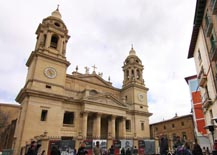
Locality: PAMPLONA (31001)
Address: Calle Dormitalería
Zone: The Pamplona Basin
Style: Gothic
Centuries of construction: XIV
Visiting hours: De lunes a viernes, de 10:00 a 14:00 y de 16:00 a 19:00. Sábados, de 10:00 a 14:00. Domingos cerrado.
Price of the visit: 4,25 euros. Descuentos especiales para determinados colectivos y para grupos.
Telephones: 948222990 – 609936934 – 948227400
Fax: 948210440
Description
Situated on the edge of the Casco Viejo (Old Quarter) of Pamplona, in the same site that the old Roman city of Pompaelo once stood, is Pamplona Cathedral, a fine example of the Gothic period (14th and 15th centuries).
This symbolic monument houses the largest number of historic and artistic relics in the city. Kings were crowned and Parliaments convened in the cathedral; indeed, it was the seat of the royal court for three centuries.
The sobriety of its neoclassical façade, a work by Ventura Rodríguez, contrasts with the Gothic interior, where the 28-metre-high central nave is home to the fine tomb of Carlos III of Navarre and his wife, Eleanor of Castile.
However, the real jewel of this cathedral is its cloister, considered among the most beautiful in the Gothic world, a must-see on every visitor’s itinerary.
Since the foundation of Pamplona in Roman times, the site of the cathedral has always been chosen as the location for the main Christian church in the city.
It was on this very spot that Carlos III ?el Noble’ ordered the construction of the present building in the purest Gothic style, inspired by other wonderful Gothic cathedrals such as that of Bayonne, in France.
Its location, on the route taken by pilgrims on their way to Santiago, dictated that its apse would be polygonal in shape, with an ambulatory, characteristic of churches on the Pilgrim’s Way.
Pamplona Cathedral was restored between 1992 and 1994.
The restoration work uncovered part of the rich polychrome that originally covered its walls, pillars and ceilings, and which concealed a 1773 repainting that simulated the colour of stone and increased the luminosity of the church, with silver-covered lamps forged in the workshops of Granada.
The restoration work confirmed the existence of previous churches from the 6th and 10th centuries, as well as bringing to light a Romanesque crypt under the apse on the left side of the building.
The cathedral façade
of neoclassical design, is undoubtedly the most controversial aspect of the whole building. The work of the Madrid architect, Ventura Rodríguez, its construction was ordered by the City Council to replace the original Roman façade, which had deteriorated badly. Fortunately, we can now see its fine capitals in the Museum of Navarre. Its main body is a faithful image of the Greek temple, with façades and columns, at the extremities of which stand two high towers. One of these houses the Campana María (Mary’s Bell), which, at twelve tons, is the second heaviest in Spain. The story goes that the border of the area known as the ?Cuenca de Pamplona’ (Pamplona Basin) is marked by the places from where the bell can be heard.
Inside
the cathedral, the Latin cross floor has three naves with chapels between the buttresses and also at the front to form the ambulatory. This grandiose and austere church is lined with vaulted transepts, flamboyant tracery windows and two rose windows.
In the central nave
lays the Mausoleo a los Reyes de Navarra (Tomb of the Kings of Navarre), Carlos III ?el Noble’ and Eleanor of Trastámara. It is a work in alabaster of great artistic value carried out by Johan Lome de Tournai. The collection of sculptures is completed by 28 sad figures of nobles and high clergy, which surround the recumbent kings, above a crypt that protects the remains of buried monarchs and princes.
A silver-covered wood carving of Santa María la Real watches over the church. The kings of Navarre were crowned, baptised and blessed before this Romanesque 12th century virgin, the oldest remaining image of Mary in Navarre.
The altarpiece by Caparroso (1507), the canvas of Brother Louis Ricci (1632), both of which are in the ambulatory, or the depiction of Christ on the Cross, the master work of Juan de Anchieta (16th century), just on the left as you enter, are the most outstanding artistic pieces in the cathedral.
The cathedral is rich in adornments and appendages.
The Claustro (cloister)
, one of the best examples of its type in the Gothic world, is a must-see for the visitor. It is essentially a masterful combination of curves and straight lines, towered over by great pointed and trefoil arches, topped by apexes with columns and highly elegant decoration and tracery.
The whole area, which comprises four passages, can be accessed through two splendid doorways. One is the Preciosa, the name of which comes from the psalm that the canons used to sing when passing through it on the way to their dormitory: “Pretiosa in conspectu Domini, mors sanctorum eius.” The other is that of Nuestra Señora del Amparo (Our Lady of Refuge), whose tympanum stands out, due to the dramatic quality that its characters relate in the Dormición de la Virgen (Death of the Virgin), and on whose central column we can see the Gothic image of a smiling virgin protected under a decorative canopy.
During your visit it is worth stopping at the tomb of Leonel, the bastard son of Carlos II, and in the Barbazana Chapel, which shelters the tomb of Bishop Arnalt de Barbazán under its star-shaped vault and which is watched over by the Virgen del Consuelo (Virgin of Consolation), an exceptional Gothic image made of polychromed stone.
Other places in the cathedral
are the Library, with more than 14,000 books, the rococo Sacristy and the Kitchen Refectory, with its 27-metre high chimney. The Diocesan Museum is situated here; it houses a valuable collection of sacred art, a highlight of which is a collection of mediaeval sculptures of the Virgin Mary.







